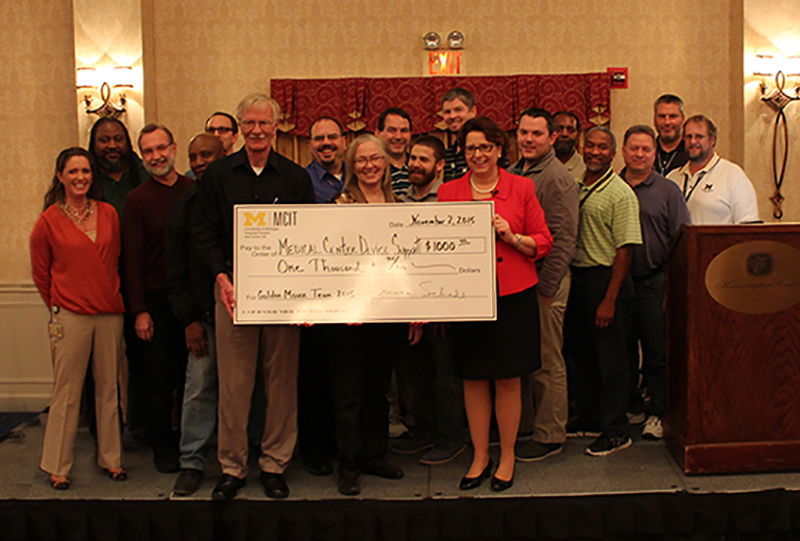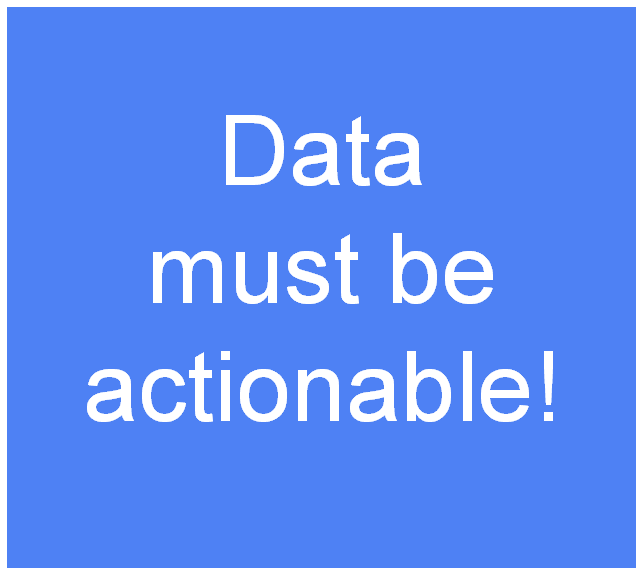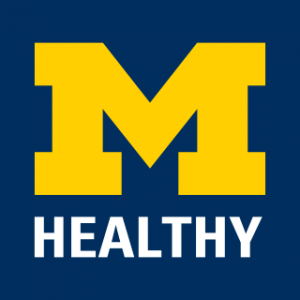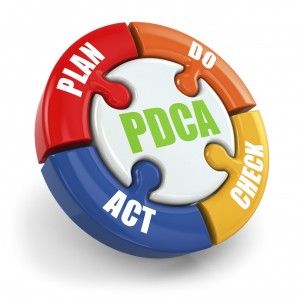 What better time than year end to reflect on our collective progress as an IT team. You will see a lot of “top 10” type stories in December – top trends, breakthroughs, stories, and even top predictions for the coming year. I’ll leave those to people with far more time to research and write. What I’d like to share is the progress my incredible IT team has made in partnership with our many internal customers at UMHS in 2015. These are common journeys for health care CIOs around the country. Continue reading
What better time than year end to reflect on our collective progress as an IT team. You will see a lot of “top 10” type stories in December – top trends, breakthroughs, stories, and even top predictions for the coming year. I’ll leave those to people with far more time to research and write. What I’d like to share is the progress my incredible IT team has made in partnership with our many internal customers at UMHS in 2015. These are common journeys for health care CIOs around the country. Continue reading
On Leadership
Tis the season to give back
 I am committed to developing the next generation of leaders. I also give generously to non-profits that I care about. This week, those two passions converged.
I am committed to developing the next generation of leaders. I also give generously to non-profits that I care about. This week, those two passions converged.
I hosted a “lunch and learn” with five women from Cisco. Jay Roberts, director operations sales, has been a strong supporter of Michigan Council of Women in Technology (MCWT), like many leaders in technology companies. At the annual MCWT gala fundraiser in October, I donated a “lunch and learn” session. I offered to meet with four women over lunch to have an open discussion on women’s leadership issues. Jay bid it up until he had no more competition. He then went back to Cisco and recommended a group of women to participate.
The women who lunched with me all currently work in the sales division for this technology company. They have different backgrounds in terms of college experience, technology education, and family history. They shared their stories and challenges with me. I asked each of them what they wanted to get out of our two hours together. After all, they all had plenty of work to do back at the office.
They wanted to talk about: work life balance and making time for self; how to lead with assertiveness and compassion yet not mother staff; common mistakes women leaders make; and where best to focus their volunteer energy.
Build bridges, not walls
 As we gather with family and friends this Thanksgiving, let us be mindful of the global society we now live in. It is a difficult time for political discourse, let alone the kind of rowdy yet friendly debates that can erupt at Thanksgiving tables with people we know well and love.
As we gather with family and friends this Thanksgiving, let us be mindful of the global society we now live in. It is a difficult time for political discourse, let alone the kind of rowdy yet friendly debates that can erupt at Thanksgiving tables with people we know well and love.
The current political climate in this country is fraught with tension. The 2016 presidential campaign dominates many news stories with more and more outrageous statements and declarations by candidates. We hear that many want to close our borders. We see the Syrian refugees seeking a new home and a safer life as they flee the war in their homeland. We grieve with the victims of the Paris terrorist attacks. And we watch with horror the continued instances of police brutality in our own cities and wonder why people have a problem with the statement “Black Lives Matter”. As I write this, I am following closely the story of white supremacists shooting protestors in my home town of Minneapolis. And on university campuses such as University of Missouri, Yale and Harvard where students seek to learn, there is racial strife that threatens to splinter them.
We sang a new hymn at church this past Sunday that really struck home for me. “Our World is One World” by Cecily Taylor included this verse:
Our world is one world, the thoughts we think affect us all. The way we build our attitudes, with love or hate, we make a bridge or wall.
When I participate in our IT department meetings and events I am reminded how wonderfully diverse we are. Continue reading
And the winner is. . .

I had my Academy Awards host moment this week at our IT department all staff meeting. It was great fun! Our Medical Center Information Technology (MCIT) department is over 600 people strong and we gather together twice a year. We present the annual employee awards at our fall meeting.
The STAR and Golden Mouse Awards are staff-to-staff awards – that means all nominations are submitted by fellow staff members. Nominations are reviewed and the winners are selected by members of the MCIT Appreciation and Recognition Team (ART).
The ART team was established to help MCIT develop and sustain a culture where contributions are recognized and accomplishments are celebrated. We are building an environment which recognizes MCIT staff who make a difference and ensures that their contributions are valued. We are creating a culture where employees are valued through events, programs, communications and awards. We measure success by increased employee engagement scores in the areas of appreciation and recognition. Continue reading
Power of Collaboration
It was a long but productive 24 hours. A team of us from the health system flew to Durham, NC, on Tuesday evening, spent a 10 hour day on Wednesday at Duke Medicine, and then flew home. It was a site visit aimed toward learning from each other and determining opportunities for collaboration.
 UMHS and Duke have similar profiles: our overall size, IT infrastructure and core applications. We are in similar places on our EHR journey with Epic. And we are both very focused on analytics – the impetus for our visit.
UMHS and Duke have similar profiles: our overall size, IT infrastructure and core applications. We are in similar places on our EHR journey with Epic. And we are both very focused on analytics – the impetus for our visit.
Duke’s CIO, Dr. Jeff Ferranti, and I know each other; we thought the proposal for a visit was a great idea. Our Chief Medical Information Officer, Dr. Andrew Rosenberg, and Duke’s Chief Health Information Officer, Dr. Eric Poon, planned and organized the day’s agenda. We let Andrew and Eric run with it and they did a terrific job!
Two important clinical leaders joined our Michigan team of several senior IT leaders — Dr. Jeff Desmond, our Chief Medical Officer, and Dr. Steve Bernstein, Associate Dean for Clinical Affairs. We needed them there as we talked broadly about analytics and support for population health. Continue reading
October is Quality Month!
Each year UMHS celebrates Quality Month and this year is no exception. Last week as part of our Lean Thinker’s Series, Dr. Richard Shannon, EVP Health Affairs, University of Virginia Health System, gave an excellent talk titled “Patient Safety and Quality: The New Currency in Academic Health Centers”.
 It was good to hear how another academic medical center is approaching similar challenges and applying lean. Some of my takeaways from his talk and the lunch discussion that followed:
It was good to hear how another academic medical center is approaching similar challenges and applying lean. Some of my takeaways from his talk and the lunch discussion that followed:
- Dr. Shannon described their Be Safe initiative – “Our Be Safe initiative is advancing our status as a high performing organization by systematically applying the scientific method (Lean Principles) to improve the safety of our patients and workforce through real time problem solving.” He shared examples of how they have reduced the incidence of hospital acquired infections, a problem for all hospitals.
- Senior executives hold a “situation room” and digital report out each morning. They spend 15 minutes reviewing critical problems that have been reported and then spend the next 45 minutes actually going to the units to understand the specific problems more deeply. And they do it on Saturdays as well.
- Their IT team plays a central role in providing data and reporting in support of their daily management system. They have developed the “Be Safe” reporting system. It is a common platform that supports daily manual entry from any employee and takes automated updates from other feeder systems. He emphasized the importance of having actionable data. All of their A3s are done online and uploaded to a library that can be queried. Patient safety events are documented with an online form as part of the system. I plan to reach out to their CIO, Rick Skinner, who has shared some of their lean stories with me in the past. Having heard Dr. Shannon’s talk, it’s time to get a much better understanding of their system.
Fall, football and fleece
Last Saturday was a wake-up call that Fall is fast approaching. With morning temps under 50, it was fleece time. It was also the first home football game for the University of Michigan under new coach Jim Harbaugh.  Blue and maize was everywhere I went in Ann Arbor. Our new coach and football team delivered a resounding victory in the first home game to everyone’s delight. But this isn’t about football or fleece, it’s about adapting to change – something we are expected to do often.
Blue and maize was everywhere I went in Ann Arbor. Our new coach and football team delivered a resounding victory in the first home game to everyone’s delight. But this isn’t about football or fleece, it’s about adapting to change – something we are expected to do often.
Yes, I donned a fleece when I ran errands and walked the dogs but I didn’t fully adapt – I still wore my sandals. I will only make that adaptation when I have to. I figure I can hold out for a few more weeks at least.
Season changes are to be expected and there’s no use fighting them. For us Northerners, yes, that means cold and snow as well in another few months. But there are many changes that we can’t anticipate, even some that seem to smack us upside the head. There are changes we choose, often after much thought and deliberation. And there are the ones we don’t choose or have no control over. But we eventually learn to embrace or at least live with them.
In our work lives there are always new processes and tools to learn and adjust to. Continue reading
Reducing costs while increasing value
Except for maybe start-up technology companies, there isn’t an IT department anywhere that has an open checkbook. In health care, we know all too well the need to manage costs while answering what seems to be an insatiable demand for technology solutions.  CIOs need to understand the technical debt of a large application portfolio and the total cost of ownership (TCO) for systems. They need to find ways to reduce the cost of commodity services, and to create capacity for new work.
CIOs need to understand the technical debt of a large application portfolio and the total cost of ownership (TCO) for systems. They need to find ways to reduce the cost of commodity services, and to create capacity for new work.
At UMHS, we have an initiative called Value and Margin Improvement, or VMI. The VMI program is a multi-year effort across the health system. UMHS leadership launched VMI to help achieve our financial stewardship goals by empowering collaborative teams to design and implement sustainable improvements that enhance value and financial results.
VMI aims at reducing duplication, inefficiencies and non-value added work in order to more effectively manage our costs, improve the value we provide and increase our margin. A positive operating margin allows us to invest in the future and better serve our patients, referring physicians, students, the research community, and other key stakeholders.
VMI projects take a balanced approach to improve and sustain overall value while still maintaining the desired safety, quality, service delivery, and employee engagement metrics. The program promotes the use of lean methodologies and collaborates with our central lean team, the Michigan Quality System (MQS).
We are systematically moving through Continue reading
Commit to a healthy workforce
Last week I joined the second “Summer Walk” that the MHealthy champions in our IT department organized. It was a 1.5 mile round trip between our two main office facilities during the lunch hour.  We had about 60 participants for each walk. What a great way to get some exercise, connect with colleagues and show our shared commitment to healthy living!
We had about 60 participants for each walk. What a great way to get some exercise, connect with colleagues and show our shared commitment to healthy living!
I wasn’t planning to do the walk when I first saw the announcements and flyers around our office. I expected that I had meetings during that time. But when one of the MHealthy champions reached out directly and asked me to show my commitment to healthy living, how could I say no? It turned out that I could join them if I left a meeting 15 minutes early. I’m glad I did; literally “walking the talk”.
Our department is so committed that we were recently recognized as being one of the top performing areas, with 58% of employees participating in the University’s MHealthy Rewards program. More than 21,000 people throughout the University took advantage of the annual opportunity to review their health status, develop an action plan for improvement, and participate in helpful programs and services such as Active U, Weight Watchers, tobacco treatment, or stress-management programs. This is the program’s seventh year.
Our department’s MHealthy workgroup is developing new plans for activities and events to promote physical activity, healthy eating, and other positive health behaviors. The Summer Walks on the last Friday of each month are just the beginning.
They have also started a FitBit community for the department. Continue reading
So what’s the problem – A3 thinking
If you don’t know what an “A3” is, don’t worry. When I started at University of Michigan Health System, I didn’t either. When I first saw an A3 meeting on my calendar, I asked “What group is that?”
There were so many groups with different acronyms! Turned out it was a meeting with a few colleagues to update our status report on major UMHS IT initiatives. We were using an A3 format for our report.
So what is an A3? It is a tool used as part of Plan-Do-Check-Act (PDCA). The A3 name actually comes from the paper size (11 x 17 sheet) that tells a story laid out from the upper left-hand side to the lower right.
Telling the story of a problem on an A3 includes looking at the background (why and what), describing its current condition (where things stand), and doing a root cause analysis. And then, establishing goals and targets, proposing countermeasures, making an action plan and determining success metrics. Continue reading

